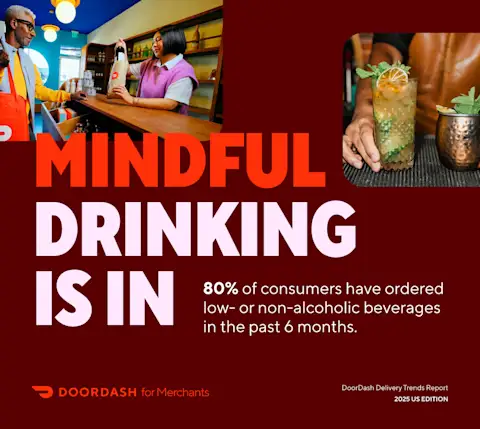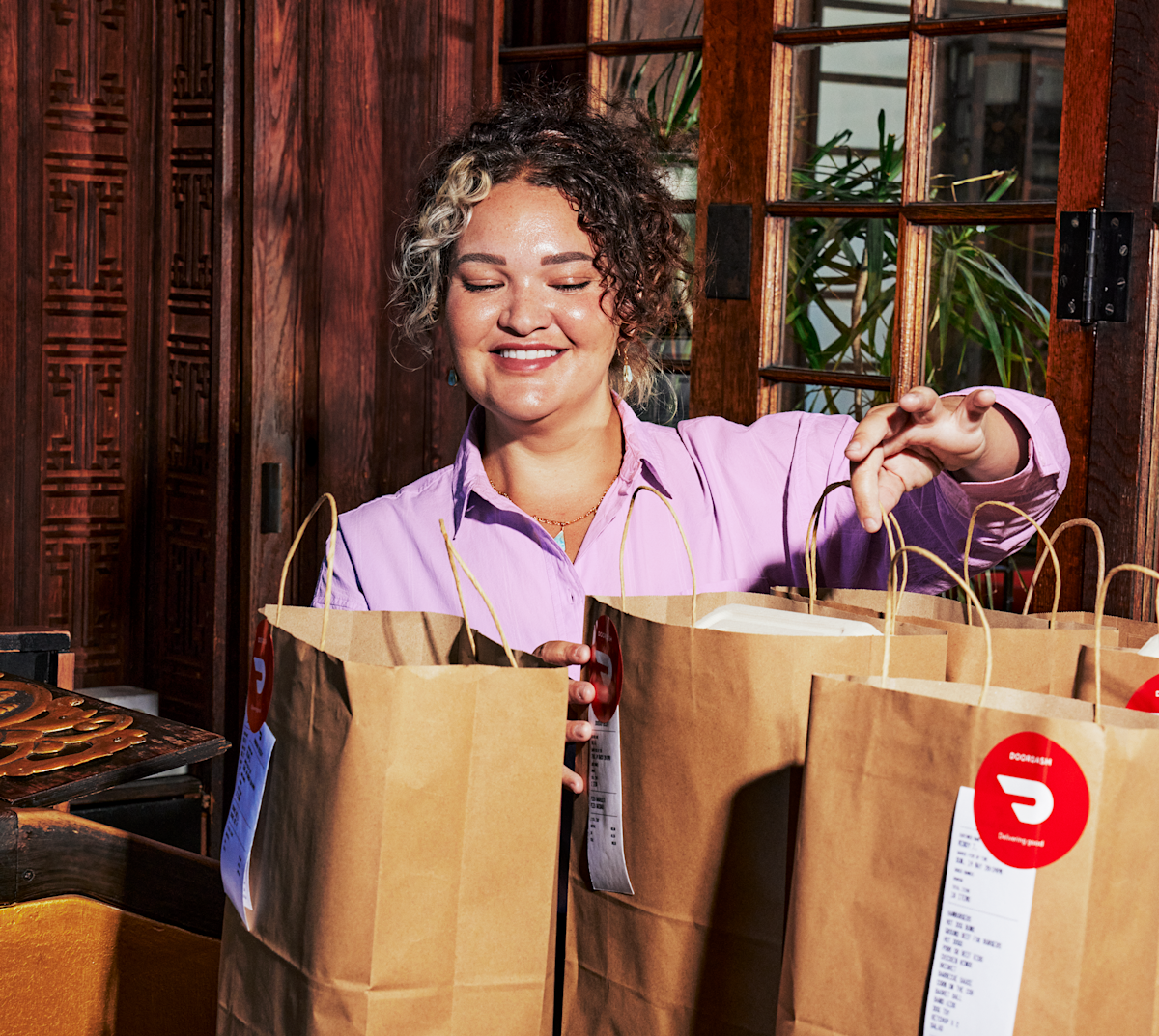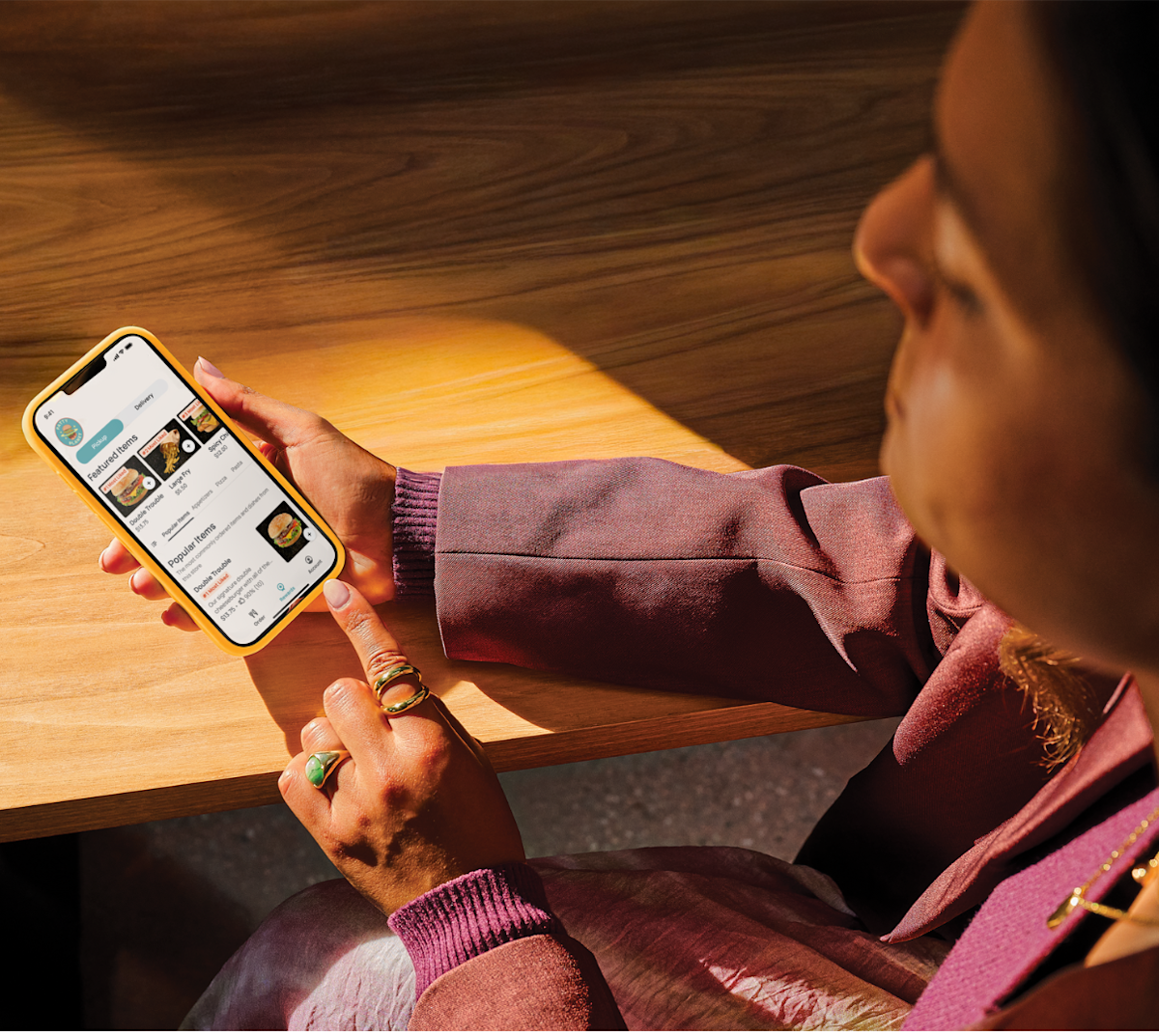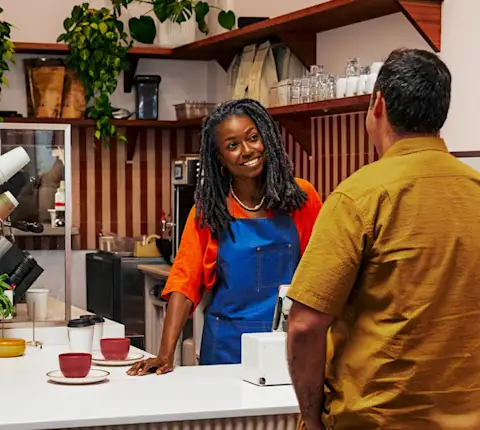The 2025 DoorDash Delivery Trends report features insights from a survey of 1,504 consumers across the US, plus aggregate data from DoorDash. Every year, DoorDash takes an in-depth look at how consumer habits are changing and what they care about most when ordering food and alcohol for delivery.
In the report, you'll learn the latest restaurant and alcohol delivery trends, with answers to these questions and more:
What drives US consumers to go from browsing to ordering?
How do restaurant online ordering habits differ by generation, region, and gender?
What do diners think about AI in the dining experience?
How is the sober curious movement impacting alcohol preferences?
Read on for the top ten takeaways from the 2025 report, and learn how to apply these insights to your restaurant to provide a positive experience for today's guests.
Want more than a quick bite of the data? Dive into the details by downloading the full report.
Download the full reportTop 10 food delivery trends in 2025
Two major themes from this year's survey are comfort and self-care. We found that most people order delivery food to satisfy cravings and as a form of self-care, and many of the top-ordered foods on DoorDash are classic comfort foods.
Social media plays a big part of restaurant discovery, too, with most consumers reporting that they’ve ordered a viral food item they saw on social media.
And with the proliferation of AI tools for consumers, like AI-assisted shopping and customer service chatbots, we asked about how folks feel about AI in the restaurant industry.
Here are the biggest takeaways from the 2025 DoorDash Delivery Trends Report.
1. Diners want robot-driven restaurant recs, but they’re not sure about AI in the kitchen
52% of consumers are comfortable with restaurants or third-party apps using AI to provide personalized recommendations, like suggested meals or new places to order from. Millennials are the most likely to be cool with this — with 60% saying they’re open to it.
But only 15% of consumers fully trust AI tools like robotic cooks or automated food assembly systems to prepare or cook their meals. Interestingly, men are 2X more likely than women to fully trust AI systems in the kitchen.
2. Social media keeps influencing dining decisions
In 2025, the top social media channels consumers use to discover new restaurants are Instagram (22%), Facebook (19%), TikTok (18%), and YouTube (16%).
Among different age groups, Gen Zers prefer TikTok, Millennials prefer Instagram, and Gen Xers and Baby Boomers prefer Facebook.
And for younger consumers, the majority of Gen Zers (67%) and Millennials (63%) trust reviews from restaurant influencers, compared to less than half of Gen Xers (45%) and Baby Boomers (28%). Interested in jumpstarting your influencer strategy? Check out our Influencer Marketing Guide for Restaurants.
3. Viral foods are driving purchases
More than half of Americans (56%) have ordered a trending restaurant item from social media for delivery. People have a strong desire to see what the hype of items like Dubai chocolate martinis and lattes, strawberry matcha, and other viral foods and drinks are really like.
Millennials (69%) and Gen Zers (74%) are even more likely to have tried a viral item, and since they’re active on social media, they can serve as a great way to spread the word about your business online.
4. Younger generations are leading the charge on sustainable dining
84% of consumers consider sustainability and ethical sourcing important when deciding on where to dine out. Sustainability is especially important to Gen Zers (92%) and Millennials (87%). But Baby Boomers are 69% more likely than the general population to say sustainability is ‘not at all important.’
The top restaurant sustainability practices Americans care about are:
Locally sourced ingredients: 36%
Food waste reduction: 35%
Ethical labor practices: 29%
Eco-friendly packaging: 28%
Organic or pesticide-free ingredients: 24%
Restaurant owners can consider tackling small changes, like using eco-friendly takeout packaging or sourcing more local and organic ingredients, and seeing how your customers respond. Then, ramp up your efforts and highlight your sustainability practices across your website, menu, and social media to attract values-driven diners.

5. Comfort food clicks with cravings-driven consumers
98% of consumers (yep, 98%!) have ordered food delivery to satisfy a craving. Sometimes, you just need buffalo chicken wings or your favorite portobello mushroom burger from that spot around the corner.
And of the top 10 foods ordered on DoorDash in 2024, many are comfort foods:
French fries
Garlic naan
Tacos
Pad thai
Miso soup
California roll
Chicken tikka masala
Edamame
Chips
Burrito
When we asked about guilty pleasures, check out what items each age group over-indexes on compared to the general population:
Baby Boomers
Cake, ice creamGen Xers
PizzaMillennials
Fast foodGen Zers
Fast food, french fries
6. Ordering in is now a form of self-care
Nearly 8 in 10 consumers (78%) think of ordering delivery as an act of self-care at least sometimes. Whether it’s after a tough day at work, busy day with the kiddos, or to celebrate a personal milestone, getting your favorite meal delivered to your doorstep is, for some people, a form of therapy.
7. Repeat restaurant delivery orders (and multi-order days) have become a habit
Consumers are ordering delivery a lot, and sometimes that means more than once a day. More than one in four millennials (27%) have ordered food delivery 3+ times in a single 24-hour period. When does convenience turn into obsession? We’re not ones to judge.
And on the theme of convenience, 47% of Americans place repeat orders at least weekly, with Millennials (55%) and parents (60%) the most likely to reorder often, some even daily.

"A customer who lives 20 minutes from Mi Vida may not want to travel here two or three times a week. But if they can have it delivered to their door, maybe they’ll have our enchiladas more often."
8. Diners prefer the convenience and ease of use of third-party apps for online ordering
46% of consumers prefer ordering out via third-party apps and websites. Why? 49% say they’re easier to use, 42% say they’re more convenient, and 22% say they’re more familiar.
On average, consumers order food delivery from third-party apps 4.6 times each month, for Gen Zers, that increases to 5.1 orders monthly.
After third-party apps, restaurant websites are the second-most preferred online ordering channel. Restaurant owners can use DoorDash Online Ordering to set up simple, commission-free online ordering directly on their own website.
9. Meal decisions happen quickly, and often last-minute
Nearly half of consumers (49%) take 5-10 minutes to make a decision about what delivery food to order, and 75% have ordered delivery last-minute in the past month. Folks are comfortable with online ordering and quickly browse and make their choices.
Restaurant operators — optimize your delivery app listing to make your menu easy to scroll through. Use photos, highlight best-sellers, and create easy-to-skim categories to help customers make faster decisions.
10. The sober curious movement is gaining steam
Year after year, low- and non-alcoholic drinks are becoming more popular, especially among American consumers. 80% of people who order alcohol for delivery have ordered low- or non-alcoholic beverages in the past six months, and we saw an 82% increase in DoorDash orders with non-alcoholic beer from 2023 to 2024.
Consider expanding your non-alcoholic beverage offerings, like zero-proof beers and creative mocktails, to cater to sober curious customers.

Get even more consumer dining and ordering trends and tips for the year ahead
Download the 2025 DoorDash Delivery Trends Report and use the dining insights to take your guest experiences to the next level.
Download the full reportMust be 21+ to order alcohol. Drink responsibly. Alcohol delivery available only in select markets.



